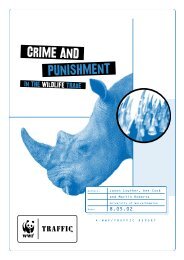In full swing: assessment of trade in orang-utans and ... - WWF UK
In full swing: assessment of trade in orang-utans and ... - WWF UK
In full swing: assessment of trade in orang-utans and ... - WWF UK
You also want an ePaper? Increase the reach of your titles
YUMPU automatically turns print PDFs into web optimized ePapers that Google loves.
, n=10). For three species for which data was available (Agile Gibbon, Siamang<br />
<strong>and</strong> Bornean Orang-utan), there were few temporal changes <strong>in</strong> the requested prices over the period 1996-2003. <strong>In</strong> the<br />
comb<strong>in</strong>ed data set, there was no relation between survey effort <strong>and</strong> number <strong>of</strong> gibbons or <strong>orang</strong>-<strong>utans</strong> encountered. Over<br />
the period 1994-2003, there was, however, a consistent <strong>and</strong> significant <strong>in</strong>crease <strong>in</strong> the number <strong>of</strong> gibbons <strong>of</strong>fered for sale<br />
at bird markets on Java, <strong>and</strong> this pattern <strong>of</strong> <strong>in</strong>crease was observed for West, Central <strong>and</strong> East Java. The data for <strong>orang</strong><strong>utans</strong><br />
was <strong>in</strong>conclusive, with an <strong>in</strong>crease observed <strong>in</strong> West <strong>and</strong> Central Java, but a decrease <strong>in</strong> East Java. Data on<br />
estimates <strong>of</strong> turnover <strong>of</strong> gibbons <strong>and</strong>/or <strong>orang</strong>-<strong>utans</strong> were difficult to obta<strong>in</strong>, but on average, one <strong>in</strong> every three visits to<br />
a bird market yields a positive record <strong>of</strong> these species, <strong>and</strong> at the larger bird markets (Jakarta, Yogyakarta <strong>and</strong> Surabaya)<br />
even one <strong>in</strong> two visits. On Java <strong>and</strong> Bali, gibbons <strong>and</strong> <strong>orang</strong>-<strong>utans</strong> are mostly <strong>trade</strong>d as pets; a small number may be<br />
bought to be used for medic<strong>in</strong>al purposes but little evidence was obta<strong>in</strong>ed dur<strong>in</strong>g this survey. Unlike some other areas<br />
<strong>in</strong> <strong>In</strong>donesia, no evidence was found on Java or Bali for the use <strong>of</strong> gibbons or <strong>orang</strong>-<strong>utans</strong> as sources <strong>of</strong> meat.<br />
Most <strong>of</strong> the gibbons <strong>and</strong> <strong>orang</strong>-<strong>utans</strong> encountered at Javan <strong>and</strong> Bal<strong>in</strong>ese bird markets orig<strong>in</strong>ate from either Sumatra or<br />
Kalimantan (<strong>In</strong>donesian Borneo). The species from Sumatra are mostly transported overl<strong>and</strong> to Java across the Sunda<br />
Strait, whereas the majority <strong>of</strong> the Bornean species arrive by sea, normally aboard ships that carry other cargoes (e.g.,<br />
timber). The large harbours along Java’s north coast (Jakarta, Tegal, Semarang, Surabaya) are the ma<strong>in</strong> ports through<br />
which the species arrive. Gibbons <strong>and</strong> <strong>orang</strong>-<strong>utans</strong> arriv<strong>in</strong>g on Bali have mostly been transported overl<strong>and</strong> (<strong>and</strong> by ferry)<br />
from Java. Most <strong>of</strong> the gibbons <strong>and</strong> <strong>orang</strong>-<strong>utans</strong> that are be<strong>in</strong>g smuggled to other countries from Java go by air, with<br />
the Soekarno-Hatta airport <strong>in</strong> Cengkareng (outside Jakarta) be<strong>in</strong>g the ma<strong>in</strong> exit po<strong>in</strong>t.<br />
Bird markets, where most <strong>of</strong> the trad<strong>in</strong>g <strong>of</strong> gibbons <strong>and</strong> <strong>orang</strong>-<strong>utans</strong> takes place, can be considered a loose network<br />
where animals are be<strong>in</strong>g transported from larger markets to smaller <strong>and</strong> from one side <strong>of</strong> the isl<strong>and</strong> to the other. The<br />
ready availability <strong>of</strong> gibbons <strong>and</strong> <strong>orang</strong>-<strong>utans</strong> (at most bird markets these can be ordered <strong>and</strong> delivered with<strong>in</strong> a matter<br />
<strong>of</strong> days or weeks at the most) suggests that the connections already exist to transport animals both to, <strong>and</strong> with<strong>in</strong>, Java<br />
<strong>and</strong> Bali.<br />
Almost 100 <strong>in</strong>dividuals <strong>of</strong> six species <strong>of</strong> gibbon <strong>and</strong> both species <strong>of</strong> <strong>orang</strong>-utan arrived at seven wildlife rescue centres<br />
<strong>in</strong> Java <strong>and</strong> Bali between 2001 <strong>and</strong> 2003. About two-thirds <strong>of</strong> these were the result <strong>of</strong> confiscations <strong>and</strong> the rema<strong>in</strong>der<br />
were received as donations. Many <strong>of</strong> the <strong>in</strong>dividuals arrived from the surround<strong>in</strong>g regencies (kabupaten) <strong>in</strong> which the<br />
wildlife rescue centres were situated, or from neighbour<strong>in</strong>g regencies. Thus, gibbons <strong>and</strong> <strong>orang</strong>-<strong>utans</strong> at the wildlife<br />
rescue centres orig<strong>in</strong>ated from only 17 out <strong>of</strong> 90 total regencies. This suggests that had confiscations <strong>and</strong> donations been<br />
more equally distributed over the isl<strong>and</strong>s, the number <strong>of</strong> <strong>in</strong>dividuals <strong>in</strong> the wildlife rescue centres could easily have been<br />
five times higher than they were.<br />
Data from 11 zoological gardens <strong>in</strong>cluded <strong>in</strong> the <strong>assessment</strong> revealed that they had a total <strong>of</strong> >300 <strong>in</strong>dividuals <strong>in</strong> their<br />
care with fewer than half be<strong>in</strong>g adults. Of those <strong>in</strong>dividuals whose orig<strong>in</strong>s were known (50%), a small proportion (c.<br />
10%) <strong>of</strong> these were said to be the result <strong>of</strong> captive breed<strong>in</strong>g <strong>and</strong> an almost equal proportion were said to be the result <strong>of</strong><br />
confiscations (26%) <strong>and</strong> donations (32%).<br />
Compar<strong>in</strong>g the three data sets (bird markets, wildlife rescue centres, <strong>and</strong> zoological gardens) shows a high consistency<br />
<strong>in</strong> species composition <strong>and</strong> relative abundance. Orang-<strong>utans</strong> do not occur naturally on Java or Bali, <strong>and</strong> hence all are<br />
imported to the isl<strong>and</strong>s. For the gibbons, when tak<strong>in</strong>g <strong>in</strong>to account their orig<strong>in</strong>, it becomes clear that over 75% <strong>of</strong> the<br />
gibbons encountered on Java <strong>and</strong> Bali have been imported to these isl<strong>and</strong>s. Thus, <strong>of</strong> 533 <strong>in</strong>dividuals, 78 <strong>in</strong>dividuals (<strong>of</strong><br />
one species) orig<strong>in</strong>ated from Java, 234 from Sumatra (5 species) <strong>and</strong> 219 from <strong>In</strong>donesian Borneo (3 species).<br />
IN FULL SWING:ASSESSMENT OF TRADE IN ORANGUTANS AND GIBBONS ON JAVA AND BALI,INDONESIA<br />
vi


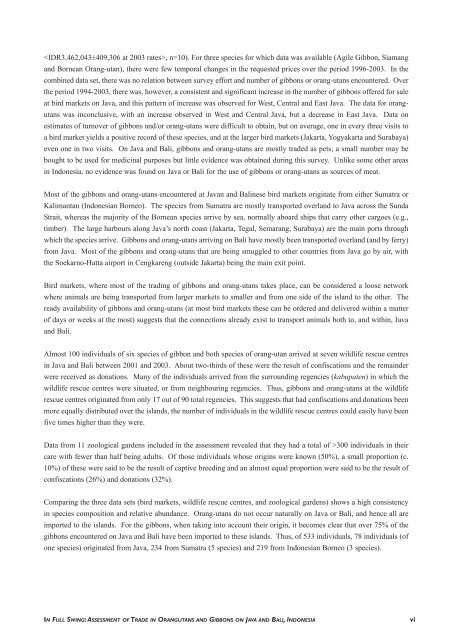
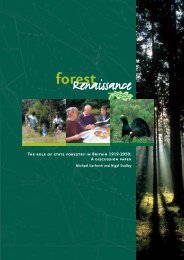
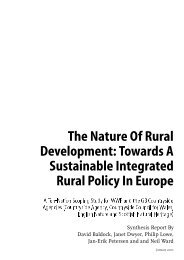
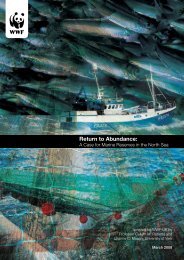

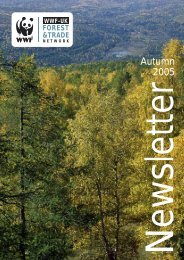

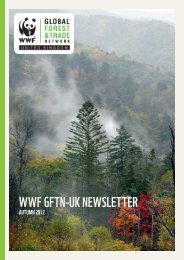
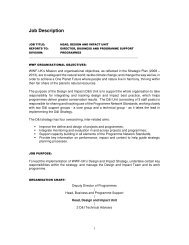
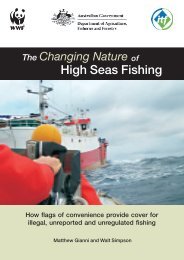
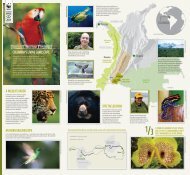
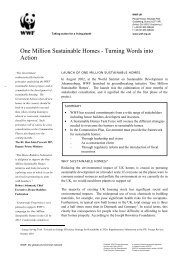
![[PDF] Causes for concern: chemicals and wildlife - WWF UK](https://img.yumpu.com/31929970/1/184x260/pdf-causes-for-concern-chemicals-and-wildlife-wwf-uk.jpg?quality=85)
